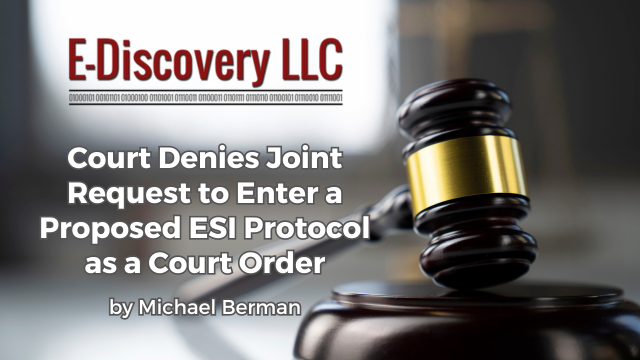
[EDRM Editor’s Note: The opinions and positions are those of Michael Berman.]
A “Joint Motion for Entry of Order Adopting Stipulation Regarding Production of Electronically Stored Information and Paper Documents” asked the court to enter an Order adopting the parties’ “Stipulation Regarding Production of Electronically Stored Information and Paper Documents” (“ESI Stipulation”).
The Joint Motion was denied. Husidic v. FR8 Solutions, Inc., 2025 WL 261383 (M.D. Fl. Sep. 10, 2025).
The Husdic court wrote that the Joint Motion: (1) contained only a “passing reference” to Fed.R.Civ.P. 26(c); (2) did not contain a memorandum of law as required by the local rules; and (3) failed to show that the entry of an order was “necessary or appropriate, particularly in light of the parties’ agreement to the procedures set forth therein.” The court wrote:
Absent authority demonstrating that entry of the ESI Stipulation by the Court, rather than private agreement amongst the parties, is proper, the Motion is due to be denied.… The Parties may at their option resolve and agree on an ESI protocol by private agreement without need for a Court Order. Otherwise, if a dispute arises regarding ESI protocols or agreements, then, after appropriate conferral, enforcement may be sought with a properly supported motion and memorandum of law.
Id. at *1 (cleaned up).
While noting that, “[t]o be sure, Rule 502(d) orders are often entered on request,”1 the court wrote that the Husdic submittal went beyond the scope of that Rule and the court criticized the drafting of the privilege non-waiver provision because it did not mention Fed.R.Evid. 502. Id. at n. 2. It also wrote that the proposal was not “clear and internally consistent.” Id. at n. 1.
It is correct that A Stipulation is a Binding Contract (Oct. 11, 2024); ESI Protocol Not Yet Entered as an Order Was Binding, But it Was Not a Fed.R.Civ.P. 34 Request (Apr. 7, 2025), citing Orlando Health, Inc. v. HKS Architects, Inc., 2025 WL 744262 (M.D. Fl. Mar. 7, 2025).
Additionally, Fed.R.Civ.P. 29(b) authorizes stipulations governing or limiting discovery, and those stipulations generally do not require court approval. The 1993 Committee Note to that Rule states: “Under the revised rule, the litigants ordinarily are not required to obtain the court’s approval of these stipulations.”
And, there is a robust debate over the question of Should an ESI Protocol Be Incorporated Into a Court Order? (Mar. 13, 2023). In McCormick & Co., Inc. v. Ryder Integrated Logistics, Inc., 2023 WL 2433902 (D. Md. March 9, 2023), the parties did not incorporate their Protocol into an order. When a dispute over the meaning of the Protocol arose, McCormick moved to have the Protocol entered as an order. That motion was granted.
However, a stipulation does not have the force of a court order. Is a Court-Ordered ESI Protocol a Trap? (Sep. 14, 2024). In that blog, I wrote: “So here is the deal with a court order, especially one that you stipulated to. It’s an order, so you have to comply with it.” Cook v. Meta Platforms, Inc., 2024 WL 4133811 (N.D. Cal. Sept. 9, 2024). The remedy for noncompliance with a court order may differ from the remedy available for noncompliance with a stipulated agreement.
So here is the deal with a court order, especially one that you stipulated to. It’s an order, so you have to comply with it.
Cook v. Meta Platforms, Inc., 2024 WL 4133811 (N.D. Cal. Sept. 9, 2024).
The Husdic court cited a Florida decision that I blogged about in Court Denied Unopposed Motions for Protective Order and Approval of ESI Protocol (Sep. 5, 2024), discussing Orlando Health, Inc. v. HKS Architects, Inc., 2024 WL 4025379 (M.D. Fl. Sept. 3, 2024).
In that blog, I asked: “I wonder what the result in Orlando Health would have been if the parties had submitted a proposed ‘discovery plan’ instead of a proposed ‘ESI Protocol.’”
This is not a mere semantic difference. The term “ESI Protocol” is not found in the Federal Rules of Civil Procedure; however, a “discovery plan” is both rules-based and mandatory. “ESI Protocol” v. “Discovery Plan” (Jan. 2, 2024); Parties Ordered to Cooperate in Good Faith and Develop a “Discovery Plan” (May 25, 2024).
Under Fed.R.Civ.P. 26(f)(2), the parties must attempt to develop a proposed “discovery plan.” Subsection (f)(2) provides that the parties must submit “to the court within 14 days after the conference a written report outlining the [discovery] plan.”
Rule 26(f)(3) describes what must be included in a “discovery plan.”2 The 2006 Committee Note states: “Rule 26(f) is amended to add to the discovery plan the parties’ proposal for the court to enter a case-management or other order adopting such an agreement…. An order that includes the parties’ agreement may be helpful in avoiding delay and excessive cost in discovery.”
An order that includes the parties’ agreement may be helpful in avoiding delay and excessive cost in discovery.
The Advisory Committee Note.
The “discovery plan” in the parties’ “report” must be considered by the court under Rule 16(b)(1)(A). The Advisory Committee Note states:
The report from the attorneys concerning their meeting and proposed discovery plan, as required by revised Rule 26(f), should be submitted to the court before the scheduling order is entered. Their proposals, particularly regarding matters on which they agree, should be of substantial value to the court in setting the timing and limitations on discovery and should reduce the time of the court needed to conduct a meaningful conference under Rule 16(b). [emphasis added].
The Advisory Committee Note.
Many courts have entered ESI Protocols as orders, even over objection. Court Orders Parties to Enter Into an ESI Protocol (Apr. 18, 2024); Litigants Can’t Agree; Judge Entered an ESI Protocol; Party Objected to It; Objections Overruled (May 17, 2025); Failure to Cooperate Leads to Judicially-Imposed ESI Protocol (Jan. 15, 2025); Failure to Confer Regarding ESI Protocol Operates Against Failing Party (Dec. 28, 2024); see Court Appointed a Special Master to Negotiate ESI Protocol (Dec. 12, 2024); Court Appointed ESI Discovery Supervisor for ESI Protocol (Sep. 13, 2024).3
Notes
- See Fed.R.Civ.P. 16(b)(3)(iv). ↩︎
- Under Rule 26(f)(3): “A discovery plan must state the parties’ views and proposals on: (A) what changes should be made in the timing, form, or requirement for disclosures under Rule 26(a), including a statement of when initial disclosures were made or will be made; (B) the subjects on which discovery may be needed, when discovery should be completed, and whether discovery should be conducted in phases or be limited to or focused on particular issues; (C) any issues about disclosure, discovery, or preservation of electronically stored information, including the form or forms in which it should be produced; (D) any issues about claims of privilege or of protection as trial-preparation materials, including — if the parties agree on a procedure to assert these claims after production — whether to ask the court to include their agreement in an order under Federal Rule of Evidence 502; (D) any issues about claims of privilege or of protection as trial-preparation materials, including the timing and method for complying with Rule 26(b)(5)(A) and–if the parties agree on a procedure to assert these claims after production–whether to ask the court to include their agreement in an order under Federal Rule of Evidence 502; (E) what changes should be made in the limitations on discovery imposed under these rules or by local rule, and what other limitations should be imposed; and (F) any other orders that the court should issue under Rule 26(c) or under Rule 16(b) and (c).” [emphasis added]. I suggest that this Rule is broad enough to encompass all provisions of an “ESI Protocol.” ↩︎
- For another decision denying a request to order an ESI Protocol, see Court Denies Joint Motion for Entry of ESI Protocol (Nov. 25, 2024), grounding the denial on noncompliance with Fed.R.Civ.P. 26(a)(1)(A)(i). ↩︎
Assisted by GAI and LLM Technologies per EDRM GAI and LLM Policy.


